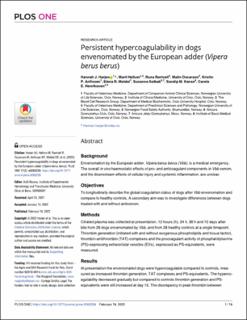| dc.description.abstract | Background Envenomation by the European adder, Vipera berus berus (Vbb), is a medical emergency. The overall in vivo haemostatic effects of pro- and anticoagulant components in Vbb venom, and the downstream effects of cellular injury and systemic inflammation, are unclear. Objectives To longitudinally describe the global coagulation status of dogs after Vbb envenomation and compare to healthy controls. A secondary aim was to investigate differences between dogs treated with and without antivenom. Methods Citrated plasma was collected at presentation, 12 hours (h), 24 h, 36 h and 15 days after bite from 28 dogs envenomated by Vbb, and from 28 healthy controls at a single timepoint. Thrombin generation (initiated with and without exogenous phospholipids and tissue factor), thrombin-antithrombin (TAT)-complexes and the procoagulant activity of phosphatidylserine (PS)-expressing extracellular vesicles (EVs), expressed as PS-equivalents, were measured. Results At presentation the envenomated dogs were hypercoagulable compared to controls, measured as increased thrombin generation, TAT-complexes and PS-equivalents. The hypercoagulability decreased gradually but compared to controls thrombin generation and PS-equivalents were still increased at day 15. The discrepancy in peak thrombin between envenomated dogs and controls was greater when the measurement was phospholipid-dependent, indicating that PS-positive EVs contribute to hypercoagulability. Lag time was shorter in non-antivenom treated dogs, compared to antivenom treated dogs <24 h after envenomation. Conclusions Hypercoagulability was measured in dogs up to 15 days after Vbb envenomation. Dogs treated with antivenom may be less hypercoagulable than their non-antivenom treated counterparts. Thrombin generation is a promising diagnostic and monitoring tool for Vbb envenomation. | |
